Report: Impact of IAS Adoption on Business Organizations
VerifiedAdded on 2020/04/07
|10
|2472
|41
Report
AI Summary
This report examines the effects of businesses adopting International Accounting Standards (IAS). It explores the impact of IAS-38 on financial statements, organizational management, and business productivity. The report discusses how IAS adoption affects the analysis of financial statements, influencing shareholder equity, goodwill, and net income. It also covers the impact on organizational management and decision-making processes, highlighting increased management control and improved communication. Furthermore, the report investigates the effects on productivity, emphasizing the importance of effective IAS implementation for financial management and investment opportunities. Finally, it analyzes the relationship between IAS adoption and business performance measures, including changes in recording, analyzing, and evaluating financial aspects. The conclusion emphasizes the positive changes that IAS can bring to a business when implemented effectively, especially in financial operations and performance measures, while referencing relevant journals and academic papers.

NAME
STUDENT ID
SUBJECT
DATE
1
STUDENT ID
SUBJECT
DATE
1
Paraphrase This Document
Need a fresh take? Get an instant paraphrase of this document with our AI Paraphraser

EXECUTIVE SUMMARY
This is report on the effects of business organizations adopting IAS policies and laws. The report
consists of four main sections. Every part composes of its own detailed information that relates
to the topic. The report shows reasons why businesses have adopted the use of IAS. The
discussion of the impacts caused by IAS adoption includes the effect on business productivity,
performance measures, management techniques and financial statement values.
2
This is report on the effects of business organizations adopting IAS policies and laws. The report
consists of four main sections. Every part composes of its own detailed information that relates
to the topic. The report shows reasons why businesses have adopted the use of IAS. The
discussion of the impacts caused by IAS adoption includes the effect on business productivity,
performance measures, management techniques and financial statement values.
2
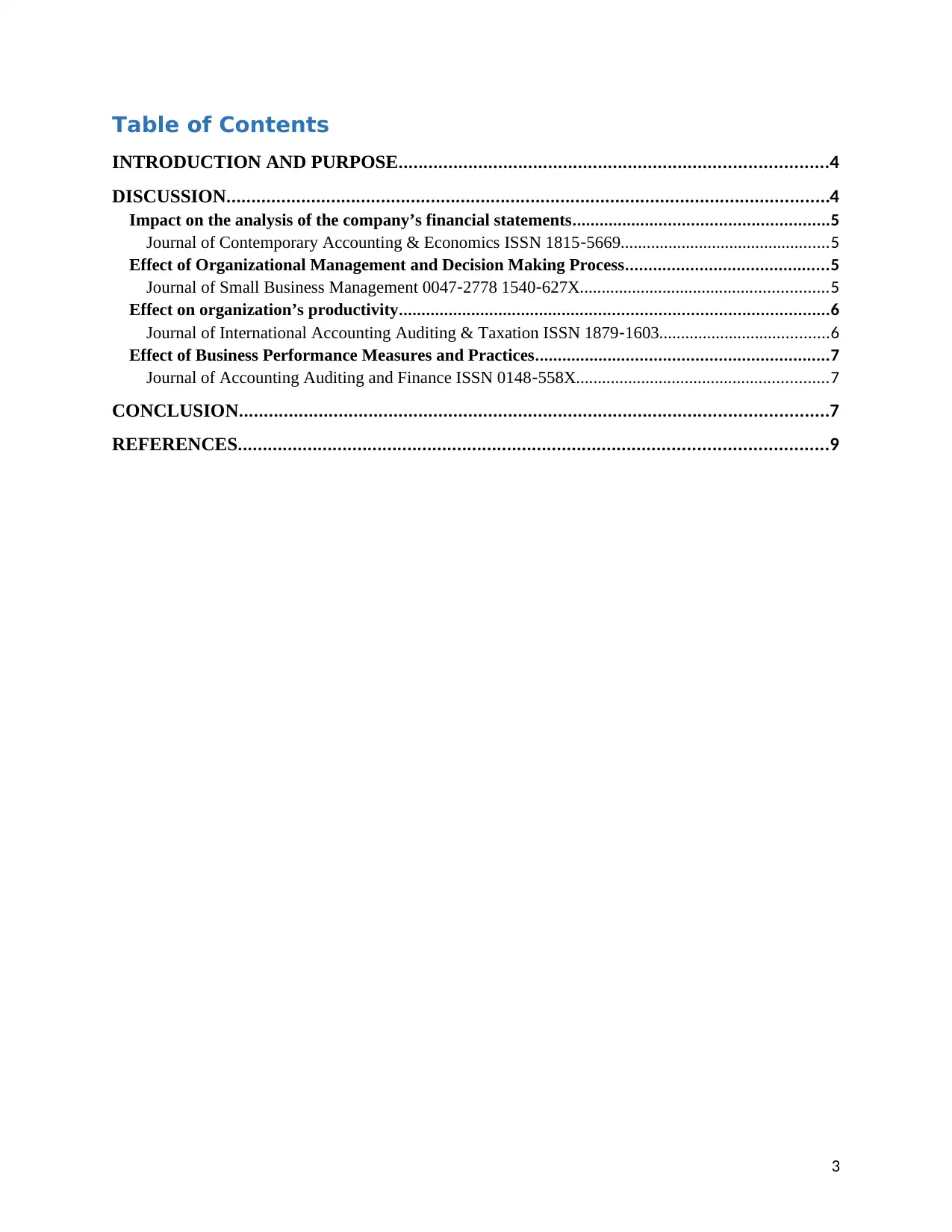
Table of Contents
INTRODUCTION AND PURPOSE......................................................................................4
DISCUSSION.........................................................................................................................4
Impact on the analysis of the company’s financial statements........................................................5
Journal of Contemporary Accounting & Economics ISSN 1815‐5669................................................5
Effect of Organizational Management and Decision Making Process............................................5
Journal of Small Business Management 0047‐2778 1540‐627X.........................................................5
Effect on organization’s productivity..............................................................................................6
Journal of International Accounting Auditing & Taxation ISSN 1879‐1603.......................................6
Effect of Business Performance Measures and Practices................................................................7
Journal of Accounting Auditing and Finance ISSN 0148‐558X..........................................................7
CONCLUSION......................................................................................................................7
REFERENCES......................................................................................................................9
3
INTRODUCTION AND PURPOSE......................................................................................4
DISCUSSION.........................................................................................................................4
Impact on the analysis of the company’s financial statements........................................................5
Journal of Contemporary Accounting & Economics ISSN 1815‐5669................................................5
Effect of Organizational Management and Decision Making Process............................................5
Journal of Small Business Management 0047‐2778 1540‐627X.........................................................5
Effect on organization’s productivity..............................................................................................6
Journal of International Accounting Auditing & Taxation ISSN 1879‐1603.......................................6
Effect of Business Performance Measures and Practices................................................................7
Journal of Accounting Auditing and Finance ISSN 0148‐558X..........................................................7
CONCLUSION......................................................................................................................7
REFERENCES......................................................................................................................9
3
⊘ This is a preview!⊘
Do you want full access?
Subscribe today to unlock all pages.

Trusted by 1+ million students worldwide

INTRODUCTION AND PURPOSE
IAS-38 is an intangible asset outline that lists the requirements for managing intangible assets. It
helps a business recognize, make use of and allocate any intangible assets into the business’s
production system. Intangible assets are those without physical or material touch, i.e. they are
non-monetary. The IAS enable a business evaluate the assets according to its policies and rules.
The introduction and adoption of the IAS into the accounting practices of a business will
certainly cause changes. Adoption of the IAS is one of the most significant practice in the
modern business world. Recently, most companies have started using the IAS policies and rules
in managing and modifying their accounting operations. The reason for this is the fact that the
accounting policies change with improvement in technology and desire for general business
development and growth (Achim and Chiş, 2014). This means that with the improvement in the
world’s aspects, the business world also desires improvement. Most businesses expect the
adoption to cause more positive changes or effects than negative effects. For instance, the
businesses expect positive effects in their productivity, their decision making processes,
management methods and techniques, their investments activities, their performance measures or
performance indicators, increase in productivity, financial statements reports to name just but a
few. On the external world, the businesses anticipate an improvement in economic change,
increase business value, better business brand and name value among other things (Beke, 2011).
However, the main issue that makes businesses adopt the IAS system is to improve its financial
management practices. This is simply because most of the policies and rules governing IAS
relate to financial control and management. They are likely to affect a business’s financial status
that any other aspect of the business. Therefore, this is the main purpose for using IAS in a
business (to manage financial status of a business, i.e. either tangible or intangible financial
factors or assets.
DISCUSSION
Impacts of adoption of AIS- 38 around the World
The use of IAS-38 is the same for many countries but the impacts are different in each country as
well as in every organization. However, the impacts lie entirely along the accounting or financial
status of a business organization. The following are some of the impacts:
4
IAS-38 is an intangible asset outline that lists the requirements for managing intangible assets. It
helps a business recognize, make use of and allocate any intangible assets into the business’s
production system. Intangible assets are those without physical or material touch, i.e. they are
non-monetary. The IAS enable a business evaluate the assets according to its policies and rules.
The introduction and adoption of the IAS into the accounting practices of a business will
certainly cause changes. Adoption of the IAS is one of the most significant practice in the
modern business world. Recently, most companies have started using the IAS policies and rules
in managing and modifying their accounting operations. The reason for this is the fact that the
accounting policies change with improvement in technology and desire for general business
development and growth (Achim and Chiş, 2014). This means that with the improvement in the
world’s aspects, the business world also desires improvement. Most businesses expect the
adoption to cause more positive changes or effects than negative effects. For instance, the
businesses expect positive effects in their productivity, their decision making processes,
management methods and techniques, their investments activities, their performance measures or
performance indicators, increase in productivity, financial statements reports to name just but a
few. On the external world, the businesses anticipate an improvement in economic change,
increase business value, better business brand and name value among other things (Beke, 2011).
However, the main issue that makes businesses adopt the IAS system is to improve its financial
management practices. This is simply because most of the policies and rules governing IAS
relate to financial control and management. They are likely to affect a business’s financial status
that any other aspect of the business. Therefore, this is the main purpose for using IAS in a
business (to manage financial status of a business, i.e. either tangible or intangible financial
factors or assets.
DISCUSSION
Impacts of adoption of AIS- 38 around the World
The use of IAS-38 is the same for many countries but the impacts are different in each country as
well as in every organization. However, the impacts lie entirely along the accounting or financial
status of a business organization. The following are some of the impacts:
4
Paraphrase This Document
Need a fresh take? Get an instant paraphrase of this document with our AI Paraphraser
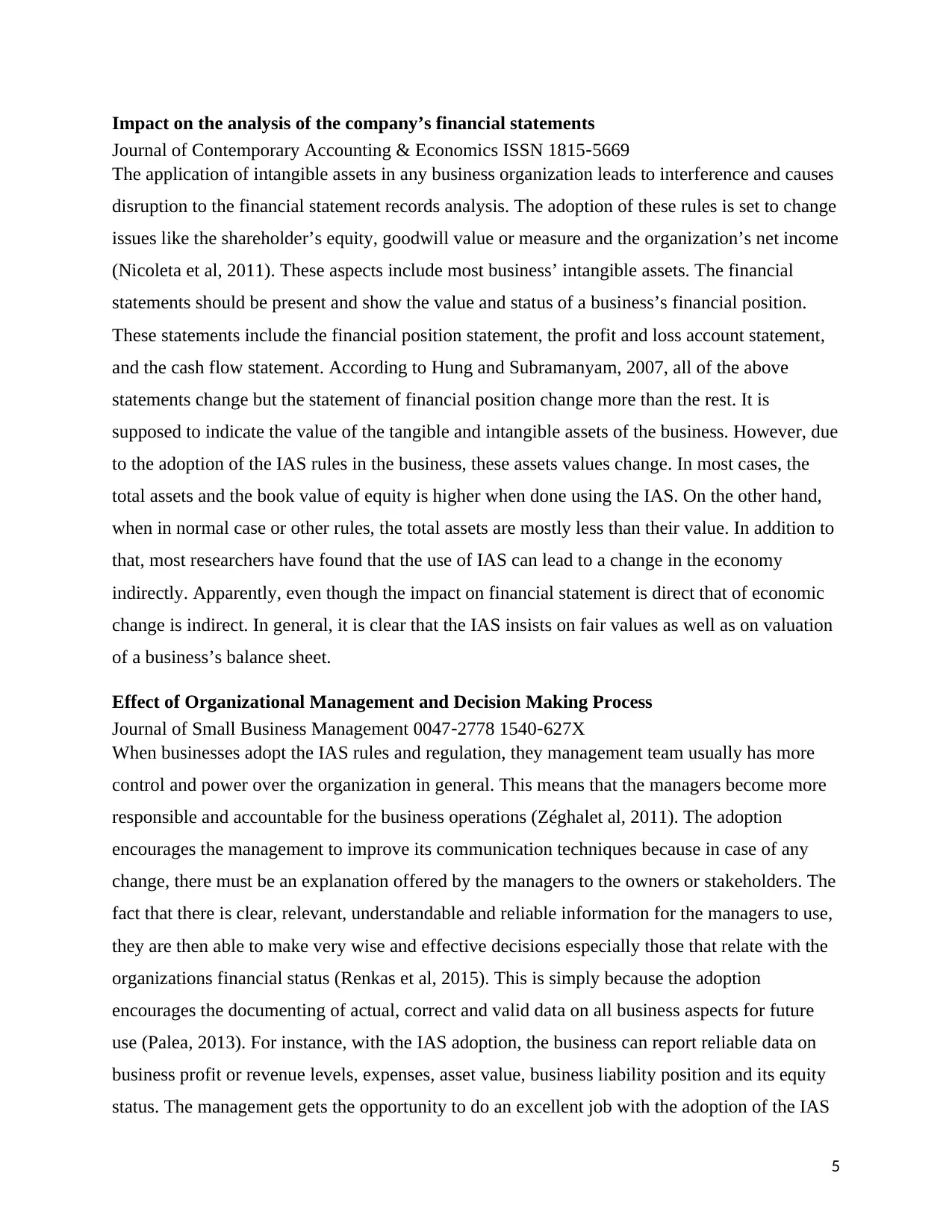
Impact on the analysis of the company’s financial statements
Journal of Contemporary Accounting & Economics ISSN 1815‐5669
The application of intangible assets in any business organization leads to interference and causes
disruption to the financial statement records analysis. The adoption of these rules is set to change
issues like the shareholder’s equity, goodwill value or measure and the organization’s net income
(Nicoleta et al, 2011). These aspects include most business’ intangible assets. The financial
statements should be present and show the value and status of a business’s financial position.
These statements include the financial position statement, the profit and loss account statement,
and the cash flow statement. According to Hung and Subramanyam, 2007, all of the above
statements change but the statement of financial position change more than the rest. It is
supposed to indicate the value of the tangible and intangible assets of the business. However, due
to the adoption of the IAS rules in the business, these assets values change. In most cases, the
total assets and the book value of equity is higher when done using the IAS. On the other hand,
when in normal case or other rules, the total assets are mostly less than their value. In addition to
that, most researchers have found that the use of IAS can lead to a change in the economy
indirectly. Apparently, even though the impact on financial statement is direct that of economic
change is indirect. In general, it is clear that the IAS insists on fair values as well as on valuation
of a business’s balance sheet.
Effect of Organizational Management and Decision Making Process
Journal of Small Business Management 0047‐2778 1540‐627X
When businesses adopt the IAS rules and regulation, they management team usually has more
control and power over the organization in general. This means that the managers become more
responsible and accountable for the business operations (Zéghalet al, 2011). The adoption
encourages the management to improve its communication techniques because in case of any
change, there must be an explanation offered by the managers to the owners or stakeholders. The
fact that there is clear, relevant, understandable and reliable information for the managers to use,
they are then able to make very wise and effective decisions especially those that relate with the
organizations financial status (Renkas et al, 2015). This is simply because the adoption
encourages the documenting of actual, correct and valid data on all business aspects for future
use (Palea, 2013). For instance, with the IAS adoption, the business can report reliable data on
business profit or revenue levels, expenses, asset value, business liability position and its equity
status. The management gets the opportunity to do an excellent job with the adoption of the IAS
5
Journal of Contemporary Accounting & Economics ISSN 1815‐5669
The application of intangible assets in any business organization leads to interference and causes
disruption to the financial statement records analysis. The adoption of these rules is set to change
issues like the shareholder’s equity, goodwill value or measure and the organization’s net income
(Nicoleta et al, 2011). These aspects include most business’ intangible assets. The financial
statements should be present and show the value and status of a business’s financial position.
These statements include the financial position statement, the profit and loss account statement,
and the cash flow statement. According to Hung and Subramanyam, 2007, all of the above
statements change but the statement of financial position change more than the rest. It is
supposed to indicate the value of the tangible and intangible assets of the business. However, due
to the adoption of the IAS rules in the business, these assets values change. In most cases, the
total assets and the book value of equity is higher when done using the IAS. On the other hand,
when in normal case or other rules, the total assets are mostly less than their value. In addition to
that, most researchers have found that the use of IAS can lead to a change in the economy
indirectly. Apparently, even though the impact on financial statement is direct that of economic
change is indirect. In general, it is clear that the IAS insists on fair values as well as on valuation
of a business’s balance sheet.
Effect of Organizational Management and Decision Making Process
Journal of Small Business Management 0047‐2778 1540‐627X
When businesses adopt the IAS rules and regulation, they management team usually has more
control and power over the organization in general. This means that the managers become more
responsible and accountable for the business operations (Zéghalet al, 2011). The adoption
encourages the management to improve its communication techniques because in case of any
change, there must be an explanation offered by the managers to the owners or stakeholders. The
fact that there is clear, relevant, understandable and reliable information for the managers to use,
they are then able to make very wise and effective decisions especially those that relate with the
organizations financial status (Renkas et al, 2015). This is simply because the adoption
encourages the documenting of actual, correct and valid data on all business aspects for future
use (Palea, 2013). For instance, with the IAS adoption, the business can report reliable data on
business profit or revenue levels, expenses, asset value, business liability position and its equity
status. The management gets the opportunity to do an excellent job with the adoption of the IAS
5
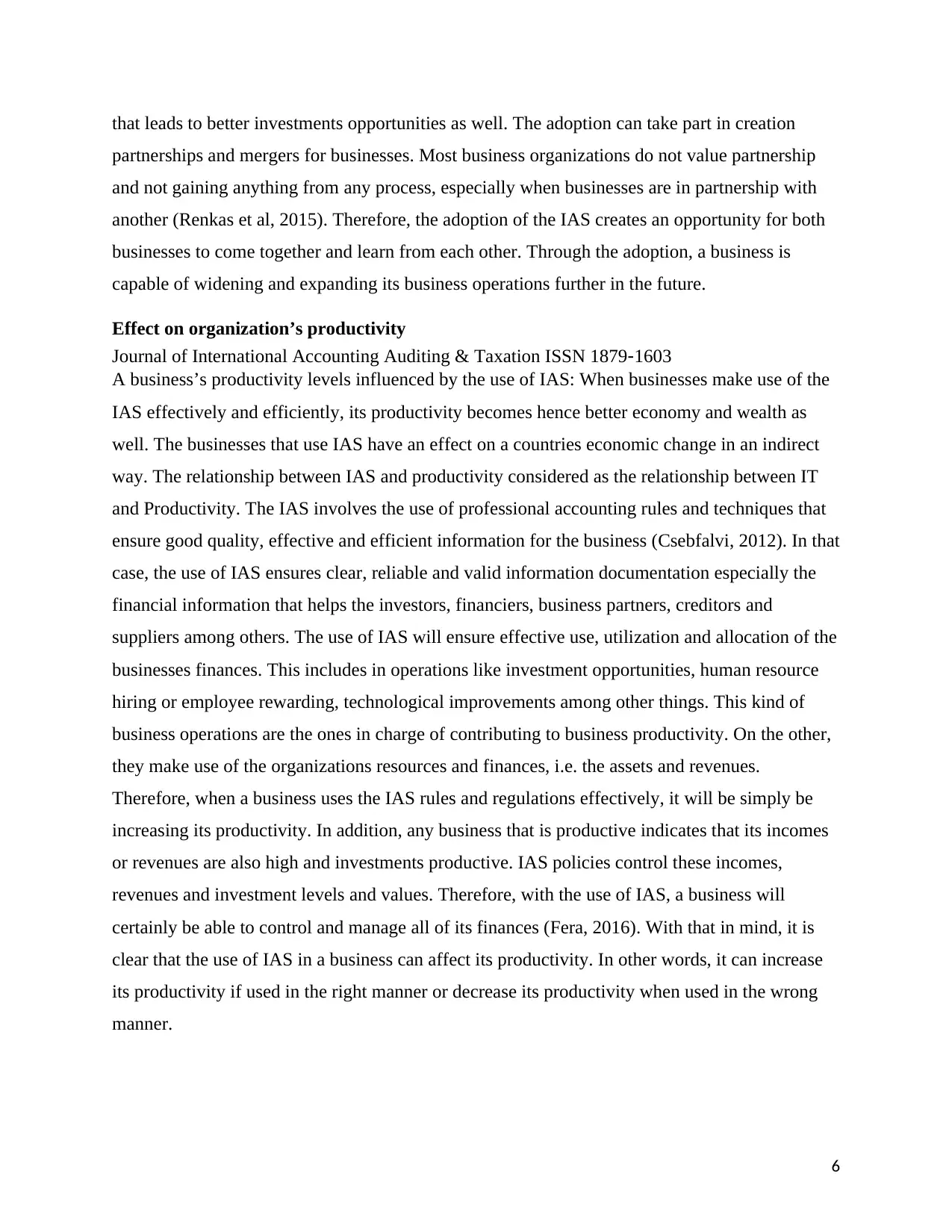
that leads to better investments opportunities as well. The adoption can take part in creation
partnerships and mergers for businesses. Most business organizations do not value partnership
and not gaining anything from any process, especially when businesses are in partnership with
another (Renkas et al, 2015). Therefore, the adoption of the IAS creates an opportunity for both
businesses to come together and learn from each other. Through the adoption, a business is
capable of widening and expanding its business operations further in the future.
Effect on organization’s productivity
Journal of International Accounting Auditing & Taxation ISSN 1879‐1603
A business’s productivity levels influenced by the use of IAS: When businesses make use of the
IAS effectively and efficiently, its productivity becomes hence better economy and wealth as
well. The businesses that use IAS have an effect on a countries economic change in an indirect
way. The relationship between IAS and productivity considered as the relationship between IT
and Productivity. The IAS involves the use of professional accounting rules and techniques that
ensure good quality, effective and efficient information for the business (Csebfalvi, 2012). In that
case, the use of IAS ensures clear, reliable and valid information documentation especially the
financial information that helps the investors, financiers, business partners, creditors and
suppliers among others. The use of IAS will ensure effective use, utilization and allocation of the
businesses finances. This includes in operations like investment opportunities, human resource
hiring or employee rewarding, technological improvements among other things. This kind of
business operations are the ones in charge of contributing to business productivity. On the other,
they make use of the organizations resources and finances, i.e. the assets and revenues.
Therefore, when a business uses the IAS rules and regulations effectively, it will be simply be
increasing its productivity. In addition, any business that is productive indicates that its incomes
or revenues are also high and investments productive. IAS policies control these incomes,
revenues and investment levels and values. Therefore, with the use of IAS, a business will
certainly be able to control and manage all of its finances (Fera, 2016). With that in mind, it is
clear that the use of IAS in a business can affect its productivity. In other words, it can increase
its productivity if used in the right manner or decrease its productivity when used in the wrong
manner.
6
partnerships and mergers for businesses. Most business organizations do not value partnership
and not gaining anything from any process, especially when businesses are in partnership with
another (Renkas et al, 2015). Therefore, the adoption of the IAS creates an opportunity for both
businesses to come together and learn from each other. Through the adoption, a business is
capable of widening and expanding its business operations further in the future.
Effect on organization’s productivity
Journal of International Accounting Auditing & Taxation ISSN 1879‐1603
A business’s productivity levels influenced by the use of IAS: When businesses make use of the
IAS effectively and efficiently, its productivity becomes hence better economy and wealth as
well. The businesses that use IAS have an effect on a countries economic change in an indirect
way. The relationship between IAS and productivity considered as the relationship between IT
and Productivity. The IAS involves the use of professional accounting rules and techniques that
ensure good quality, effective and efficient information for the business (Csebfalvi, 2012). In that
case, the use of IAS ensures clear, reliable and valid information documentation especially the
financial information that helps the investors, financiers, business partners, creditors and
suppliers among others. The use of IAS will ensure effective use, utilization and allocation of the
businesses finances. This includes in operations like investment opportunities, human resource
hiring or employee rewarding, technological improvements among other things. This kind of
business operations are the ones in charge of contributing to business productivity. On the other,
they make use of the organizations resources and finances, i.e. the assets and revenues.
Therefore, when a business uses the IAS rules and regulations effectively, it will be simply be
increasing its productivity. In addition, any business that is productive indicates that its incomes
or revenues are also high and investments productive. IAS policies control these incomes,
revenues and investment levels and values. Therefore, with the use of IAS, a business will
certainly be able to control and manage all of its finances (Fera, 2016). With that in mind, it is
clear that the use of IAS in a business can affect its productivity. In other words, it can increase
its productivity if used in the right manner or decrease its productivity when used in the wrong
manner.
6
⊘ This is a preview!⊘
Do you want full access?
Subscribe today to unlock all pages.

Trusted by 1+ million students worldwide
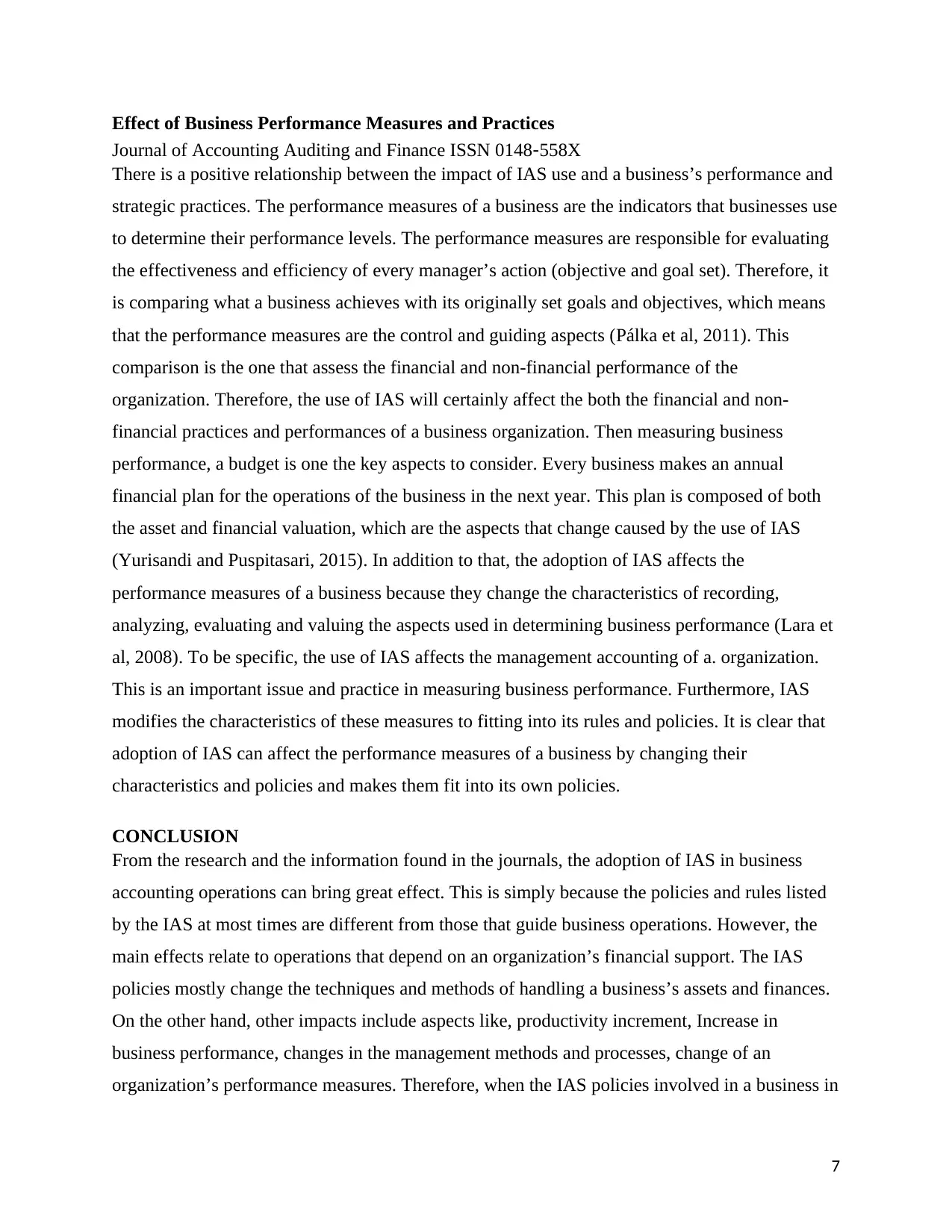
Effect of Business Performance Measures and Practices
Journal of Accounting Auditing and Finance ISSN 0148‐558X
There is a positive relationship between the impact of IAS use and a business’s performance and
strategic practices. The performance measures of a business are the indicators that businesses use
to determine their performance levels. The performance measures are responsible for evaluating
the effectiveness and efficiency of every manager’s action (objective and goal set). Therefore, it
is comparing what a business achieves with its originally set goals and objectives, which means
that the performance measures are the control and guiding aspects (Pálka et al, 2011). This
comparison is the one that assess the financial and non-financial performance of the
organization. Therefore, the use of IAS will certainly affect the both the financial and non-
financial practices and performances of a business organization. Then measuring business
performance, a budget is one the key aspects to consider. Every business makes an annual
financial plan for the operations of the business in the next year. This plan is composed of both
the asset and financial valuation, which are the aspects that change caused by the use of IAS
(Yurisandi and Puspitasari, 2015). In addition to that, the adoption of IAS affects the
performance measures of a business because they change the characteristics of recording,
analyzing, evaluating and valuing the aspects used in determining business performance (Lara et
al, 2008). To be specific, the use of IAS affects the management accounting of a. organization.
This is an important issue and practice in measuring business performance. Furthermore, IAS
modifies the characteristics of these measures to fitting into its rules and policies. It is clear that
adoption of IAS can affect the performance measures of a business by changing their
characteristics and policies and makes them fit into its own policies.
CONCLUSION
From the research and the information found in the journals, the adoption of IAS in business
accounting operations can bring great effect. This is simply because the policies and rules listed
by the IAS at most times are different from those that guide business operations. However, the
main effects relate to operations that depend on an organization’s financial support. The IAS
policies mostly change the techniques and methods of handling a business’s assets and finances.
On the other hand, other impacts include aspects like, productivity increment, Increase in
business performance, changes in the management methods and processes, change of an
organization’s performance measures. Therefore, when the IAS policies involved in a business in
7
Journal of Accounting Auditing and Finance ISSN 0148‐558X
There is a positive relationship between the impact of IAS use and a business’s performance and
strategic practices. The performance measures of a business are the indicators that businesses use
to determine their performance levels. The performance measures are responsible for evaluating
the effectiveness and efficiency of every manager’s action (objective and goal set). Therefore, it
is comparing what a business achieves with its originally set goals and objectives, which means
that the performance measures are the control and guiding aspects (Pálka et al, 2011). This
comparison is the one that assess the financial and non-financial performance of the
organization. Therefore, the use of IAS will certainly affect the both the financial and non-
financial practices and performances of a business organization. Then measuring business
performance, a budget is one the key aspects to consider. Every business makes an annual
financial plan for the operations of the business in the next year. This plan is composed of both
the asset and financial valuation, which are the aspects that change caused by the use of IAS
(Yurisandi and Puspitasari, 2015). In addition to that, the adoption of IAS affects the
performance measures of a business because they change the characteristics of recording,
analyzing, evaluating and valuing the aspects used in determining business performance (Lara et
al, 2008). To be specific, the use of IAS affects the management accounting of a. organization.
This is an important issue and practice in measuring business performance. Furthermore, IAS
modifies the characteristics of these measures to fitting into its rules and policies. It is clear that
adoption of IAS can affect the performance measures of a business by changing their
characteristics and policies and makes them fit into its own policies.
CONCLUSION
From the research and the information found in the journals, the adoption of IAS in business
accounting operations can bring great effect. This is simply because the policies and rules listed
by the IAS at most times are different from those that guide business operations. However, the
main effects relate to operations that depend on an organization’s financial support. The IAS
policies mostly change the techniques and methods of handling a business’s assets and finances.
On the other hand, other impacts include aspects like, productivity increment, Increase in
business performance, changes in the management methods and processes, change of an
organization’s performance measures. Therefore, when the IAS policies involved in a business in
7
Paraphrase This Document
Need a fresh take? Get an instant paraphrase of this document with our AI Paraphraser

an effective and efficient manner, it will certainly bring positive change to the business and vice
versa.
8
versa.
8
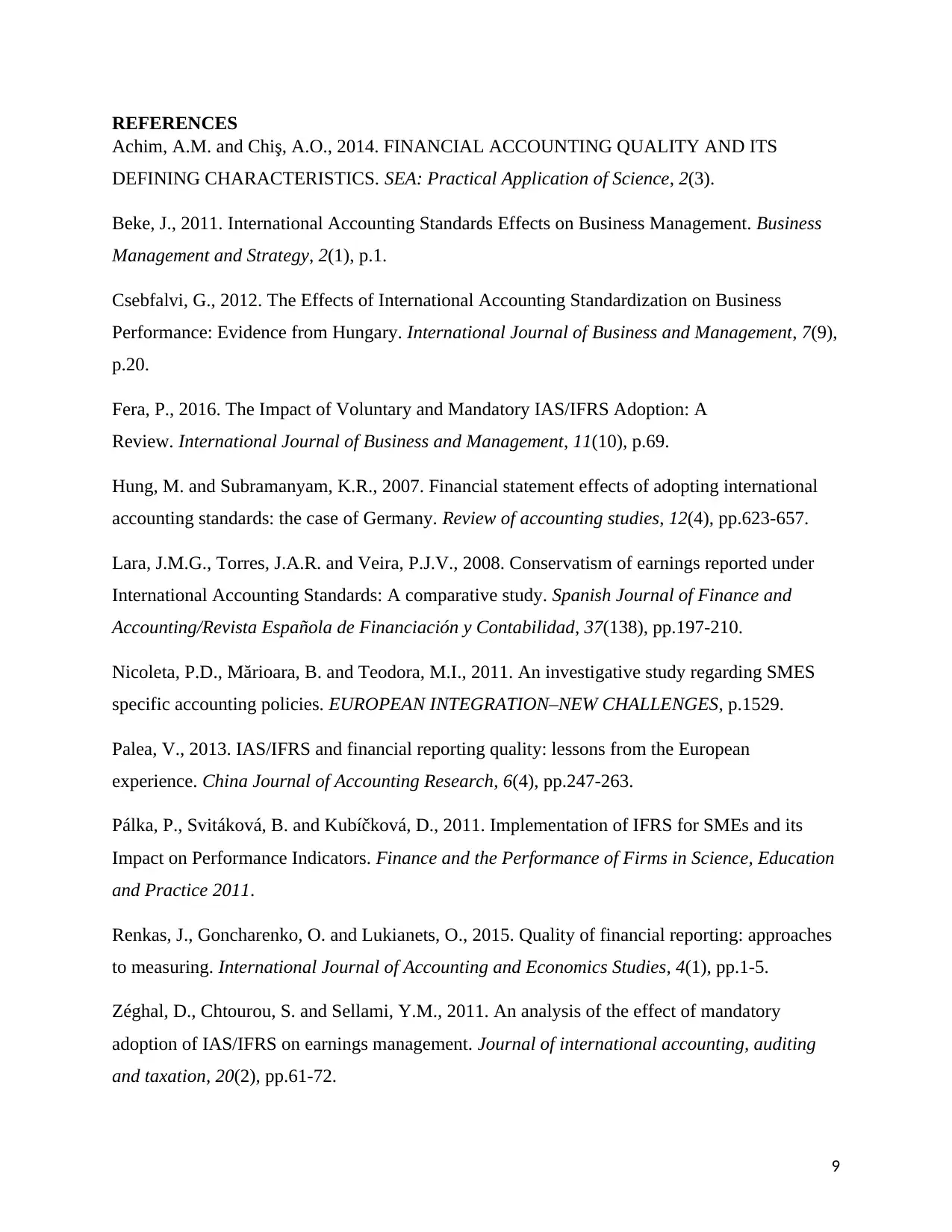
REFERENCES
Achim, A.M. and Chiş, A.O., 2014. FINANCIAL ACCOUNTING QUALITY AND ITS
DEFINING CHARACTERISTICS. SEA: Practical Application of Science, 2(3).
Beke, J., 2011. International Accounting Standards Effects on Business Management. Business
Management and Strategy, 2(1), p.1.
Csebfalvi, G., 2012. The Effects of International Accounting Standardization on Business
Performance: Evidence from Hungary. International Journal of Business and Management, 7(9),
p.20.
Fera, P., 2016. The Impact of Voluntary and Mandatory IAS/IFRS Adoption: A
Review. International Journal of Business and Management, 11(10), p.69.
Hung, M. and Subramanyam, K.R., 2007. Financial statement effects of adopting international
accounting standards: the case of Germany. Review of accounting studies, 12(4), pp.623-657.
Lara, J.M.G., Torres, J.A.R. and Veira, P.J.V., 2008. Conservatism of earnings reported under
International Accounting Standards: A comparative study. Spanish Journal of Finance and
Accounting/Revista Española de Financiación y Contabilidad, 37(138), pp.197-210.
Nicoleta, P.D., Mărioara, B. and Teodora, M.I., 2011. An investigative study regarding SMES
specific accounting policies. EUROPEAN INTEGRATION–NEW CHALLENGES, p.1529.
Palea, V., 2013. IAS/IFRS and financial reporting quality: lessons from the European
experience. China Journal of Accounting Research, 6(4), pp.247-263.
Pálka, P., Svitáková, B. and Kubíčková, D., 2011. Implementation of IFRS for SMEs and its
Impact on Performance Indicators. Finance and the Performance of Firms in Science, Education
and Practice 2011.
Renkas, J., Goncharenko, O. and Lukianets, O., 2015. Quality of financial reporting: approaches
to measuring. International Journal of Accounting and Economics Studies, 4(1), pp.1-5.
Zéghal, D., Chtourou, S. and Sellami, Y.M., 2011. An analysis of the effect of mandatory
adoption of IAS/IFRS on earnings management. Journal of international accounting, auditing
and taxation, 20(2), pp.61-72.
9
Achim, A.M. and Chiş, A.O., 2014. FINANCIAL ACCOUNTING QUALITY AND ITS
DEFINING CHARACTERISTICS. SEA: Practical Application of Science, 2(3).
Beke, J., 2011. International Accounting Standards Effects on Business Management. Business
Management and Strategy, 2(1), p.1.
Csebfalvi, G., 2012. The Effects of International Accounting Standardization on Business
Performance: Evidence from Hungary. International Journal of Business and Management, 7(9),
p.20.
Fera, P., 2016. The Impact of Voluntary and Mandatory IAS/IFRS Adoption: A
Review. International Journal of Business and Management, 11(10), p.69.
Hung, M. and Subramanyam, K.R., 2007. Financial statement effects of adopting international
accounting standards: the case of Germany. Review of accounting studies, 12(4), pp.623-657.
Lara, J.M.G., Torres, J.A.R. and Veira, P.J.V., 2008. Conservatism of earnings reported under
International Accounting Standards: A comparative study. Spanish Journal of Finance and
Accounting/Revista Española de Financiación y Contabilidad, 37(138), pp.197-210.
Nicoleta, P.D., Mărioara, B. and Teodora, M.I., 2011. An investigative study regarding SMES
specific accounting policies. EUROPEAN INTEGRATION–NEW CHALLENGES, p.1529.
Palea, V., 2013. IAS/IFRS and financial reporting quality: lessons from the European
experience. China Journal of Accounting Research, 6(4), pp.247-263.
Pálka, P., Svitáková, B. and Kubíčková, D., 2011. Implementation of IFRS for SMEs and its
Impact on Performance Indicators. Finance and the Performance of Firms in Science, Education
and Practice 2011.
Renkas, J., Goncharenko, O. and Lukianets, O., 2015. Quality of financial reporting: approaches
to measuring. International Journal of Accounting and Economics Studies, 4(1), pp.1-5.
Zéghal, D., Chtourou, S. and Sellami, Y.M., 2011. An analysis of the effect of mandatory
adoption of IAS/IFRS on earnings management. Journal of international accounting, auditing
and taxation, 20(2), pp.61-72.
9
⊘ This is a preview!⊘
Do you want full access?
Subscribe today to unlock all pages.

Trusted by 1+ million students worldwide
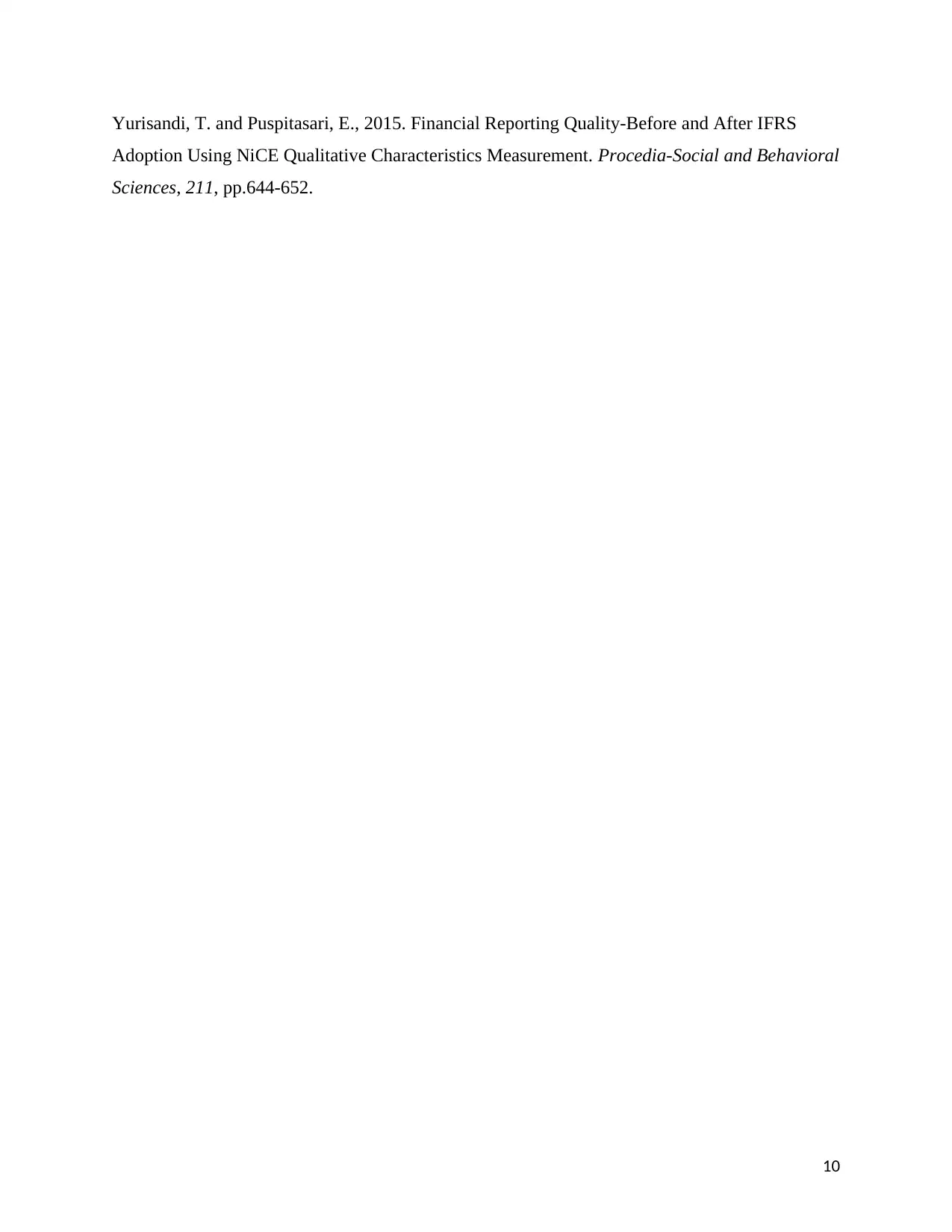
Yurisandi, T. and Puspitasari, E., 2015. Financial Reporting Quality-Before and After IFRS
Adoption Using NiCE Qualitative Characteristics Measurement. Procedia-Social and Behavioral
Sciences, 211, pp.644-652.
10
Adoption Using NiCE Qualitative Characteristics Measurement. Procedia-Social and Behavioral
Sciences, 211, pp.644-652.
10
1 out of 10
Related Documents
Your All-in-One AI-Powered Toolkit for Academic Success.
+13062052269
info@desklib.com
Available 24*7 on WhatsApp / Email
![[object Object]](/_next/static/media/star-bottom.7253800d.svg)
Unlock your academic potential
Copyright © 2020–2025 A2Z Services. All Rights Reserved. Developed and managed by ZUCOL.





